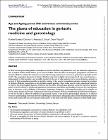| dc.contributor.author | Romero-Ortuno, Roman | |
| dc.date.accessioned | 2022-02-21T16:21:07Z | |
| dc.date.available | 2022-02-21T16:21:07Z | |
| dc.date.issued | 2022 | |
| dc.date.submitted | 2022 | en |
| dc.identifier.citation | Roman Romero-Ortuno, Andreas E. Stuck, Tahir Masud, The giants of education in geriatric medicine and gerontology, Age and Ageing, 2022 | en |
| dc.identifier.other | Y | |
| dc.identifier.uri | http://hdl.handle.net/2262/98147 | |
| dc.description | PUBLISHED | en |
| dc.description.abstract | In 2014, the European undergraduate curriculum in Geriatric Medicine was published to cover the minimum requirements that a medical student should achieve by the end of medical school. In 2019, the European postgraduate curriculum in Geriatric Medicine outlined the minimum recommended training requirements to become a geriatrician at specialist level in the EU. The postgraduate dimension of Geriatric Medicine education is a highly relevant topic for all, since most physicians—independently of their specialty—are inevitably involved in the care of older patients, but for most physicians, geriatrics is not part of their postgraduate generalist or specialty training. A key area for postgraduate education remains the provision of Geriatric Medicine competencies to all specialties outside geriatrics. There is also need for wider educational initiatives to improve the gerontological education of patients and the public. Bernard Isaacs famously coined the expression ‘geriatric giants’ or the four clinical I’s: Intellectual impairment, Incontinence, Immobility, and Instability. However, non-clinical giants exist. In education, we face challenges of Investment, Inspiration, Integration, and Interprofessionality; and in research, we need to attract Interest and Income, and generate Innovation and Impact. Without strengthening the links between all giants, we will not be able to achieve the ambition of age-attuned societies. A key goal for gerontological education is to enhance everyone’s understanding of the wide diversity underlying the ‘older people’ demographic label, which will ultimately promote services and societies that are more responsive and inclusive to the needs of all older adults, irrespective of their health status. | en |
| dc.language.iso | en | en |
| dc.relation.ispartofseries | Age and Ageing; | |
| dc.rights | Y | en |
| dc.subject | Older people | en |
| dc.subject | Geriatrics | en |
| dc.subject | Gerontology | en |
| dc.subject | Curricula | en |
| dc.subject | Europe | en |
| dc.title | The giants of education in geriatric medicine and gerontology | en |
| dc.type | Journal Article | en |
| dc.type.supercollection | scholarly_publications | en |
| dc.type.supercollection | refereed_publications | en |
| dc.identifier.peoplefinderurl | http://people.tcd.ie/romeroor | |
| dc.identifier.rssinternalid | 234197 | |
| dc.identifier.doi | https://doi.org/10.1093/ageing/afac004 | |
| dc.rights.ecaccessrights | openAccess | |
| dc.subject.TCDTheme | Ageing | en |
| dc.subject.TCDTheme | Inclusive Society | en |
| dc.identifier.orcid_id | 0000-0002-3882-7447 | |




